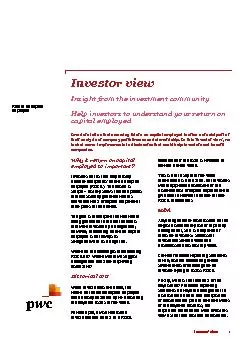

1 Investor view Insight from the investment community Help investors to understand your return on capital employed tell us that assessing return on captial employed is often a crucial par t of thei ID: 840767
Download Pdf The PPT/PDF document "Investor view" is the property of its rightful owner. Permission is granted to download and print the materials on this web site for personal, non-commercial use only, and to display it on your personal computer provided you do not modify the materials and that you retain all copyright notices contained in the materials. By downloading content from our website, you accept the terms of this agreement.
1 Investor view 1 Investor v
Investor view 1 Investor view Insight from the investment community Help investors to understand your return on capital employed tell us that assessing return on captial employed is often a crucial par t of their analysis of company performance and stewardship . In this âInvestor viewâ, we look at some improvements to disclosure s that could help investors and benefit companies. Why is return on capital employed so important ? I nvestors tell us that they closely monitor companiesâ return on capital employed (ROCE) . The reason is simple â history shows that companies that consistently generate returns their peers in the market . The goal is to compare the real return being generated to the real amounts that were invested by management; h owever, calculating return on capital employed is not always as straightforward as it might be . Where do the challenges to calculating ROCE lie? Where would we suggest management disclosure? Historical cost When investments are made, the return on the actual capital employed can be easily obscured by re - measuring the acquired assets to fair valu e . For example, a wise real estate investment can be lost in a ROCE calculation if the is revalued to current market value. This is not to say that fair value information is not usef ul. But i nvestors would appreciate disclosure of the historical cost of capital expenditure to give them a relevant number in their ROCE calculations. M&A Acquiring another business can be the largest use of capital by management, so it is a key area of focus for investors : successful investments create value and unsuccessful ones destroy value. Current financial reporting standards for acquisition accounting create several areas of challenge for an i nvestor trying to assess ROCE. Firstly, what is the total cost of the Financial reporting standards do require management to disclose the amount and composition of consideration paid to former owners of the acquired business , but important de tail about what investors view as the total cost can be obscured . Return on capital employed Investor view 2 © 201 3 PricewaterhouseCoopers. All rights reserved. PricewaterhouseCoopers refers to the network of member firms of PricewaterhouseC oopers International Limited, each of which is a separate and independent legal entity. Contact your local PricewaterhouseCoop ers office to discuss these issues. To discover more about the reporting issues that the investment community is talking about, visit: www.corporatereporting.com . To read other editions in this âInvestor view sâ series, visit: www.pwc.com/ifr
2 s and click on âInvestor viewsâ in
s and click on âInvestor viewsâ in the left - hand navigator. To subscribe to future editions, email corporatereporting@uk.pwc.com For example, i nvestors want to be able to see the debt acquired, pension liabilities assumed , etc . in order to base their evaluation of the return on the capital on the real cost. Secondly, there is the income statement impact. A clear description of the intangibles acquired , distinguis hing between those acquired assets that have a finite life (eg a patent) and those that are sustained through expenditure that goes through the income stateme nt (eg customer lists and brands) is very useful. Many companies make adjustments for amortisation of all acquired intangible assets in their chosen measure of earnings, but investors often tell us that the ir models only adjust for the latter . Finally, th ere is need to assess whether the acquisition has, over time, created or destroyed value. Management will typically discuss the strategic rationale for any acquisition made. However, once the acquisition has been finalised, it can be difficult to assess wh ether the stated strategic ambitions have been met. Investors would welcome clear disclosure of the returns from the acquired assets or businesses - whether in pure financial terms, or through a mixture of financial performance and strategic objectives achieved - so they can analyse relative success in future periods . W atch our short webcast featuring investors talking about what they need from M&A disclosures, a vailable here . Consistency is key! Investors tell us consistency is crucial to enable them to replicate managementâs ROCE calculations. B eing transparent about how management measures ROCE is critical. In vestors encourage management to keep definitions consistent year on year â or to restate prior years if changes are made. Using a ROCE measure that reconciles to GAAP is also important . A management number based on internal management accounts may be usef ul for managing the company, but if an investor cannot replicate the calculation, it can be frustrating for their analysis , especially if their models are different in some way . The more granular the better Segmental reporting is often the bedrock of an investorâs analysis of a company. Companies could really help investors by disclosing some information about capital employed on a segmental basis. For example, d isclosing PP & E, cap ital expenditure and working capital on a segmental basis would be a helpful improvement. W atch our short webcast featuring investors talking about what they need from s egmental disclosures, a vailable here .